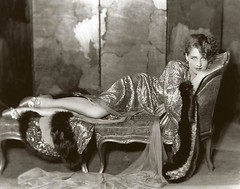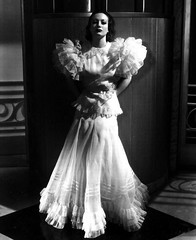Thu 25 Sep, 2008
STA-RITE
Comments (0) Filed under: Hair PinsTags: Bullocks Wilshire, George Hurrell, Irving Thalberg, Joan Crawford, Letty Lynton, Norma Shearer, Pancho Barnes, Ramon Navarro
Doesn’t the woman on the Sta-Rite hair pin card resemble the sophisticated movie stars of the 1930s?
Some of the most stunning cosmetics packaging was designed and manufactured during the 1930s. In 1933, the worst year of the Great Depression, one in four people were out of work. Many others would be thrown off of their farms and out of their homes. With so much day to day uncertainty and hardship people took pleasure in small things.

Bullocks Wilshire, Los Angeles
Imagine that you’re a shop girl at the Bullock’s department store in Los Angeles during the 1930s. The clientele would have been upscale, and after a full day of waiting on them your feet would be aching and your spirits might be low — yet with only a few pennies in your handbag, you could go to your local dime store and pick up something beautiful. With a card of the Sta-Rite hair pins you could go home and experiment with a new hair style – perhaps something with a few wicked little pin curls on your forehead.

Joan Crawford
The Sta-Rite card is an excellent example of some of the best cosmetics/beauty advertising produced during the 1930s. The colors are deep and lush, and the woman is supremely stylish, all angles and shadows, with just a hint of a smile playing across her lips. In fact, the woman on the card is evocative of the portrait of Joan Crawford by George Hurrell. I wonder if Joan used Sta-Rite pins to get “…the tiny ringlets and curls that fashion demands”.

Norma Shearer in a sultry pose
During the late 1920s Hurrell was introduced to silent film star Ramon Navarro by aviatrix Pancho Barnes. Navarro was impressed by the photos taken of him and recommended Hurrell to the actress Norma Shearer. Norma was married to MGM producer Irving Thalberg and was trying to convince him to cast her in the starring role in the film “The Divorcee“. Norma’s career had been built on playing the girl next door, and she was seeking sexier, more complex roles. Irving Thalberg was knocked out by Hurrell’s photos of Norma. The photos were so alluring – she smoldered – that she won the part she wanted. She also won an Academy Award TM!
Norma would go on to appear in many successful pre-code films for MGM such as: Let Us Be Gay (1930), Strangers May Kiss (1931), A Free Soul (1931), Private Lives (1931) and Riptide (1934); and Norma and Joan would be bitter rivals in the 1939 film The Women.

Joan Crawford wearing the Letty Lynton dress
Joan Crawford’s career would have an astonishing upward trajectory for decades. Hurrell’s photograph of Joan for the 1932 film Letty Lynton made the dress she wore so popular that it was reported that between authorized copies and knock-offs over one million of the dresses sold world wide!
Despite the furor over the glorious organdy dress (designed by Adrian), the film would be pulled from distribution due to a lawsuit over copyright infringement. Unfortunately, Letty Lynton remains unavailable to this day [although a fuzzy copy in multiple parts appears on YouTube.]**
I’ll bet that the Sta-Rite woman would have wholeheartedly approved of the careers of Joan Crawford and Norma Shearer – both of whom were glamorous, sexy, and sophisticated.
**NOTE: Updated info as of August 10, 2010. The Letty Lynton video that was available on YouTube when this was first posted has been pulled by the studio. There are undoubtedly still bootlegged copies in private collections.


